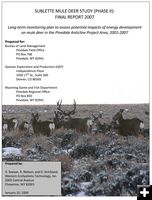Deer study summarized
by Western Ecosystems Technology Inc executive summary
February 17, 2009
Through 2007, gas field development in the Mesa portion of the Pinedale Anticline Project Area (PAPA) resulted in 1,520 acres of direct habitat loss from the construction of well pads and access roads. Although 70 miles of roads were built on the Mesa between 2000 and 2007, most (83%) habitat loss was associated with well pads, particularly as gas field development progressed. Direct habitat loss represented less than 3% of the Mesa surface area, but did not include the relatively short-term losses from pipeline construction. Given the number of wells approved in the PAPA, directional drilling strategies have reduced direct habitat loss by drilling multiple wells (up to 28) from single pads.
Radiomarked deer avoided well pads 6 of the 7 years of development, resulting in indirect habitat loss that was substantially larger than the direct habitat loss. Mule deer avoidance of well pads appeared to be associated with the amount of human activity that occurred at the pads, as winter drill pads were avoided the most and producing pads with liquids gathering systems (LGS) were avoided the least. Our results suggest that efforts to minimize direct and indirect habitat loss should focus on technology and planning that reduce the number of well pads and the human activity associated with them. Specifically, our results indicate that indirect habitat loss associated with producing well pads may be reduced by 38-63% with the installation of LGS.
Conversely, indirect habitat loss associated with winter drill pads were approximately 3 to 9 x greater than producing well pads. In short, LGS appeared to be an effective long-term (i.e., production phase) mitigation measure for reducing indirect habitat loss to wintering mule deer, while year-round drilling in crucial winter range created a short-term (i.e., drilling phase) increase in deer disturbance and indirect habitat loss. Despite changes in winter habitat selection and distribution patterns during years of gas field development, the migration routes of mule deer to and from the Mesa remained intact and functional.
Average daily movement rates of mule deer on the Mesa were approximately 1.6 km/day, while those on the Pinedale Front were 2.3 km/day. Within each winter range, the daily movement rates were consistent among months and years, even with the variable environmental and field development conditions (e.g., weather, truck traffic, drill rigs, and pad numbers) that mule deer were exposed to during the study period. Given that most mule deer on the Mesa did not move more than 1.6 km/day and that those movements were generally restricted to a relatively small home range, many small habitat treatments evenly distributed across the Mesa may benefit more mule deer than a few large treatments.
We attempted to examine and compare estimates of mule deer abundance, recruitment, adult female survival, and winter fawn survival between a treatment (the Mesa) and reference (Pinedale Front) area to determine if gas development affected population performance. However, problems with the reference area (i.e., no abundance estimates, more severe winter conditions, and consistent off-road snowmobile/ATV disturbance) made comparisons between the treatment and reference areas difficult.
Nonetheless, data collected from the Mesa indicated that mule deer numbers declined during the first 4 years (2001-2004) of gas development and increased the following 3 years (2005-2007), for an overall decline of 30%. When survival and recruitment rates estimated from the Mesa were incorporated into a population growth model (White and Lubow 2002), the model predicted a 27% decline. During the same time period, the Wyoming Game and Fish Department (WGFD) estimated a 10% decline for the larger Sublette Herd Unit, which included the Mesa and several other winter ranges. When we consider that 1) there was a negative trend in deer abundance (-30%) observed in the Mesa, 2) the population growth model indicated that the negative trend was plausible given the reproductive and survival rates we measured, 3) estimated emigration rates for the Mesa were only 1.5% per year, and 4) WGFD estimates for the entire Sublette Herd Unit indicated that deer numbers declined by only 10% over the same time period, we conclude that mule deer numbers declined in the Mesa and there is no evidence that suggests other segments of the Sublette mule deer population declined at a comparable rate.
|
